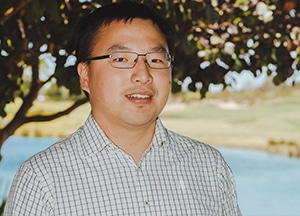Nov 14 2019
Research performed at Monash University has unraveled new spin textures in pyrite-type materials, enabling the potential use of these materials in future spintronics devices. The analysis of these materials offers new understanding and opportunities for achieving selective spin control in topological spintronics devices.
 FLEET Research Fellow Dr Yuefeng Yin. Image Credit: Monash University.
FLEET Research Fellow Dr Yuefeng Yin. Image Credit: Monash University.
Seeking New Spin in Topological Materials
Topological materials exhibit excellent capabilities that can be leveraged for next-generation, ultra-low energy electronics, such as thermoelectric and spintronic devices.
One limitation that hampers the use of such materials for spintronics is that all topological materials investigated so far feature spin states that are aligned parallel to the plane of the material. However, many/most/all practical spintronic devices would necessitate out-of-plane spin states.
Creating and controlling out-of-plane spins without the application of an external electric or magnetic field has been the main difficulty in spintronics.
For the first time, the new study at Monash Engineering has shown that pyrite-type crystals can exhibit unconventional direction- and energy-dependent spin textures on the surface, including both out-of-plane and in-plane spin components. This is in stark contrast to spin textures in traditional topological materials.
A number of pyrite-type materials have previously been theoretically predicted to show the desired out-of-plan spin textures.
Dr Yuefeng Yin, Study Lead Author, Computational Materials Lab, Faculty of Engineering, Monash University
Pyrite, which is commonly known as “fool’s gold,” is an iron-sulfide mineral that exhibits several internal planes of electronic symmetry.
The presence of strong local symmetry protects out-of-plan spin states, so we decided to look closer at some of these crystals.
Dr Yuefeng Yin, Study Lead Author, Computational Materials Lab, Faculty of Engineering, Monash University
The unconventional spin texture found by the researchers paves the way for new possibilities for the essential task of detecting or injecting out-of-plane spin component in future topological spintronic devices.
The Study
Selective control of surface spin current in topological pyrite-type OsX2 (X = Se, Te) crystals was reported in NPJ Quantum Materials in August 2019.
The Monash researchers used first-principles calculations to isolate surface spin states by their interactions with spin states in the bulk of the material. This led to a highly anisotropic, yet tunable, behavior.
In addition to financial support from the Australian Research Council (Centre of Excellence and ARC Laureates funding), the authors thankfully acknowledge computational support from the Monash Campus Cluster, Pawsey Supercomputing Facility, and NCI computational facility.
The Link Between Symmetry and Topological Materials
The occurrence of powerful, local symmetry offers topological robustness to spin states. Therefore, symmetry is a strong predictor of topological behavior. Hence, the study of these phenomena in pyrite crystals should offer clues for finding several other new topological materials.
Topological insulators are innovative materials that act as electrical insulators from within. However, they can carry current along their edges. In contrast to a traditional electrical path, topological edge paths such as these have the ability to carry electrical current with near-zero dissipation of energy. This implies that topological transistors can switch without consuming more energy.
Topological materials are studies as part of FLEET’s Research theme 1, which seeks ultra-low resistance electronic paths that can be used to develop a new class of ultra-low energy electronics.
FLEET is an Australian Research Council-funded research center that brings together more than a hundred Australian and international experts to create a new class of ultra-low energy electronics.